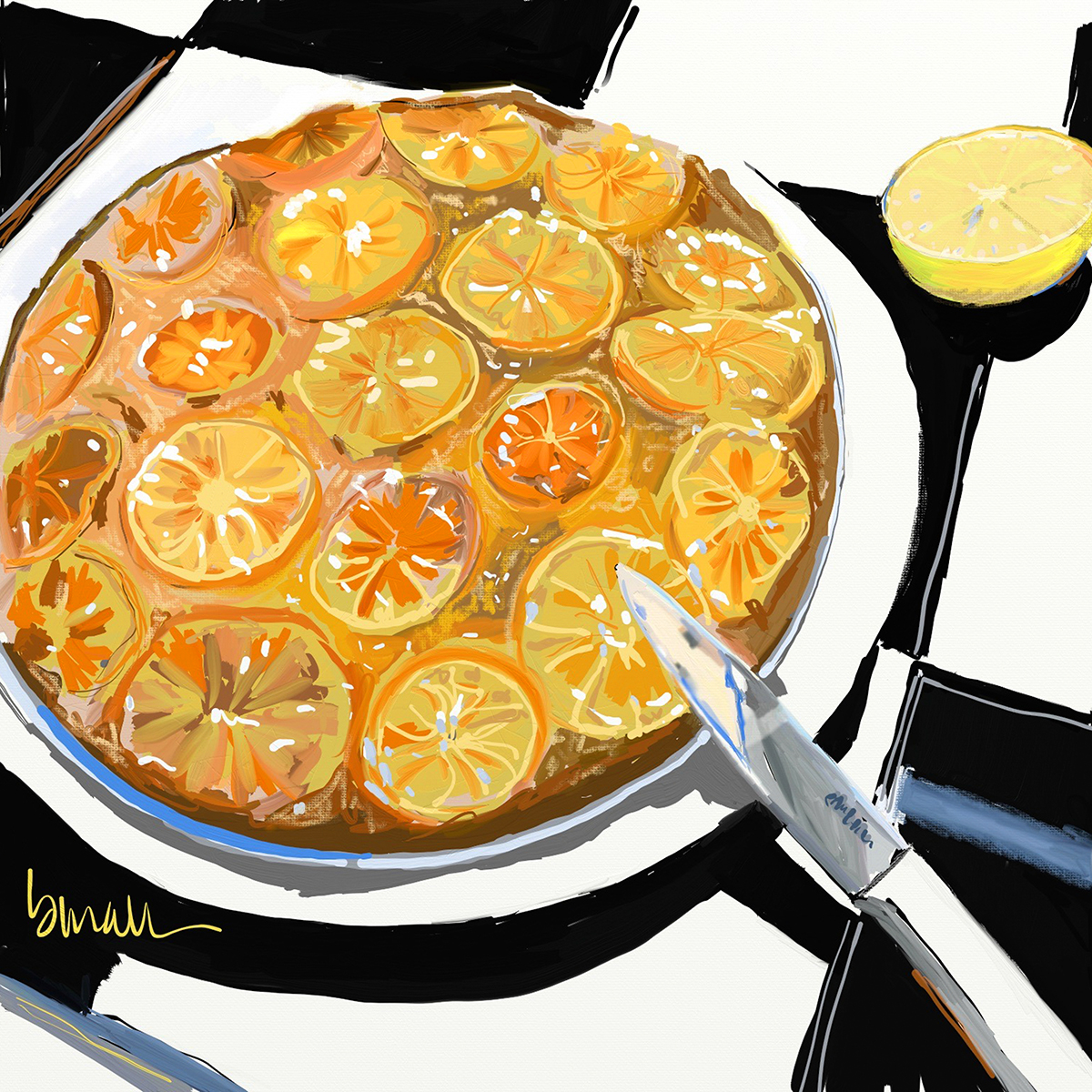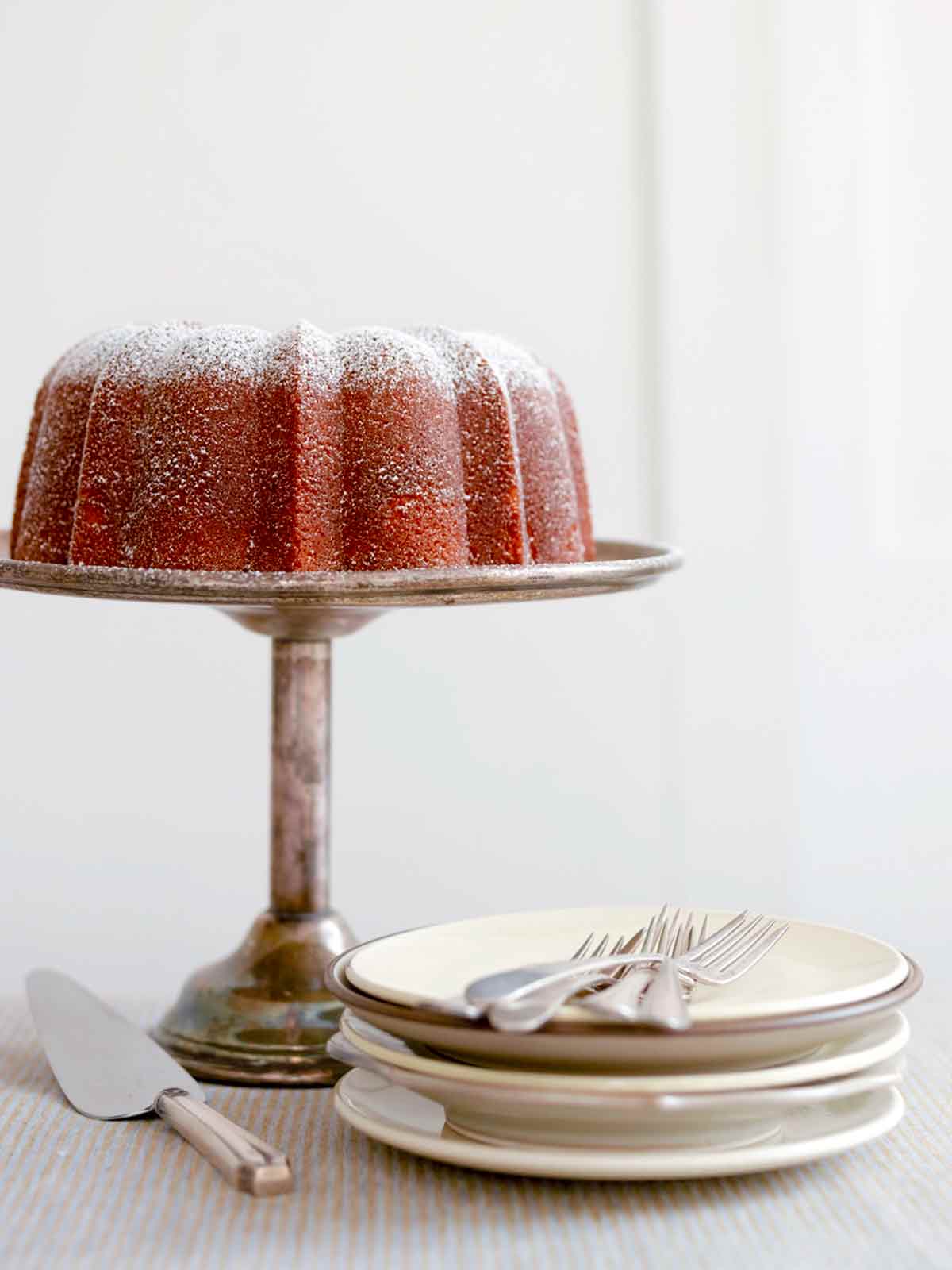
This clementine cake may look like an upside-down cake and taste like an upside-down cake but it couldn’t be more right-side-up. And there’s no scary moment of reckoning—or rather, wrecking—that requires you to scarily turn out the rich, buttery cake and its sticky sweet topping from the pan while preventing it from crumbling or cracking.
Incidentally, this clementine cake was originally called a satsuma cake, which sounds sorta exotic but simply refers to the category of all those cute little orbs of citrus that are ubiquitous at grocery stores each winter, including clementines, tangerines, even smallish navel oranges. Use whichever you fancy or can get your hands on. Any citrus with few or no seeds and thin peels that are easy to slip off works spectacularly well.

Why Our Testers Loved This
There’s a whole bunch of reasons our recipe testers adored this citrus dessert. Helen D. loved that it was “very flavorful, with minimal effort,” and Lynne B was pleased with the “buttery and not too sweet” flavor. All of our testers received rave reviews from their own guests.
Notes on Ingredients
- Citrus–Any thin-skinned citrus will work here, including clementines, tangerines, or satsumas. Avoid thick-skinned fruit, like navel oranges, grapefruits, and lemon as they will make the cake too. bitter.
- Semolina flour-This adds texture and flavor to the cake, however, you can substitute all-purpose flour, if you prefer.
How to Make This Recipe
- Zest and juice one fruit, and thinly slice the remaining fruit. Combine the orange and lemon juices, sugar, salt, and orange slices, and bring to a simmer. Cook the fruit until tender, then transfer them to a plate and continue to simmer the syrup until reduced.
- Heat the oven to 375°F. Butter a springform pan.
- Beat the butter and sugar until fluffy. Add the eggs one at a time, then beat in the zest. Sift the dry ingredients together and mix them into the batter.
- Pour the batter into the prepared pan. Arrange the candied oranges over the batter. Bake for 15 minutes, then reduce the oven temperature to 350°F and continue to cook until the cake is golden brown.
- Cool the cake on a wire rack. Poke holes all over the cake and brush over the reserved glaze.
Recipe FAQs
Clementines are a variety of mandarin orange that are thin-skinned, easy-to-peel, and seedless. They are also one of the sweetest varieties of oranges, making them a popular component of many dishes, including celery root salad, and as a sweet counterpart to rich roasted duck.
Yes, any type of thin-skinned citrus will work here. Satsumas or tangerines are great substitutes. The most critical attribute of whatever citrus that you select for this recipe—whether satsumas, tangerines, clementines, or smallish navel oranges—isn’t the tartness of the segments so much as the thickness (or, if you will, thinness) of the peel, which remains on the citrus while it’s candied to keep the lovely circles of segments intact and to impart an ever so slight bitterness to the stunningly sweet glaze as a little welcome contrast.
Fear not, the rinds soften sufficiently to be fork-friendly and turn sweet enough to be palate-pleasing, but only if you use thin-skinned citrus. Thicker-skinned citrus such as regular oranges just don’t play nicely in the time allowed, and simmering them a little longer until they do turn tender brings bitter consequences, both in terms of taste and the inescapable fact that the citrus segments tend to sag and fall apart.
That said, if you can only find thick-skinned citrus, we have a fix for you. One of our veteran recipe testers, Helen Doberstein, was so taken by this simple and stunning recipe—yet vexed by the thick peels she was finding in grocery stores—that she kept tinkering until she had an aha! moment. She microwaved thicker citrus slices prior to simmering them.
The cake is lovely all on its own, whether for dessert, afternoon tea, or even breakfast. That said, we’d never turn down a dollop of whipped cream on top.
Pro Tips
- Use room temperature ingredients to ensure a smooth batter and light texture in the finished cake.
- Leftover cake can be stored at room temperature, wrapped in plastic, for up to 3 days.
- To reheat clementine cake, microwave a slice for 10 to 15 seconds.

Write a Review
If you make this recipe, or any dish on LC, consider leaving a review, a star rating, and your best photo in the comments below. I love hearing from you.–David
It may be the best cake I’ve ever made or eaten, and I’ve been doing both for nigh on 60 years. I think it may become a Christmas dessert, and the cake base itself may become a canvas for some more cakes as the seasons change.
norman

Clementine Cake
Equipment
- 9- or 10-inch (23- or 25-cm) springform pan
Ingredients
For the glazed citrus
- 6 thin-skinned satsumas, clementines, tangerines, blood oranges, or small navel oranges, preferably organic
- Juice of 1/2 lemon, (about 2 tablespoons)
- 1 cup granulated sugar
- 1/4 teaspoon kosher salt
For the clementine cake
- 1 stick (4 oz) unsalted butter, at room temperature, plus more for the pan
- 3/4 cup granulated sugar
- 2 large eggs, at room temperature
- 1/3 cup semolina flour, (or substitute all-purpose flour)
- 2/3 cup all-purpose flour
- 1 teaspoon baking powder
- 1/4 teaspoon salt
Instructions
Make the glazed citrus
- Finely grate the zest of 1 of the citrus fruits to make about 1 teaspoon zest. Reserve it for the cake batter. Cut that citrus fruit in half, juice it, and strain the juice; you should have 1/3 cup juice. (There's a chance you may need a second citrus to yield sufficient juice.)
- Slice the remaining citrus fruits into very thin circles—not paper thin, mind you, but no more than 1/4 inch (6 mm) thick. Remove and discard any seeds. [Editor's Note: If using thicker-skinned citrus, slice the citrus 1/4 inch (6 mm) thick, place the slices on a plate, and microwave on high for 1 to 3 minutes, depending on how thick the peels. This helps ensure the thick peel softens without turning the fruit clinging to it to mush.]
- In a medium nonreactive saucepan over low heat, combine the orange juice, lemon juice, sugar, salt, and orange slices and bring to a slow simmer. Cook until the centers of the orange slices are starting to become tender and translucent but aren't falling apart and the peels are tender, 6 to 10 minutes, depending on the thickness. If the peels aren't yet tender enough to cut with a fork, keep simmering until they are.
- Using a slotted spoon, carefully transfer the orange slices to a plate. Continue to simmer the syrup until it reduces to 1/2 cup, anywhere from 10 to 25 minutes, depending on how long you simmered the orange slices and the size of your pan. Remove from the heat.
☞ TESTER TIP: You may want to pour the remaining syrup into a pyrex measuring cup using a spatula to scrape the pan. This made it easier to microwave later because it's a lot easier to pour the syrup onto the cake when it's warm.
Make the clementine cake
- Preheat the oven to 375°F (190°C). Butter a 9- or 10-inch springform cake pan.
- Toss the butter and sugar in the bowl of a stand mixer fitted with the paddle attachment and beat on medium speed until fluffy. With the mixer still running, add an egg and mix until it's completely and indisputably incorporated before adding the second egg. When the second egg is similarly incorporated, sprinkle the grated orange zest reserved from the glaze recipe over the batter and mix until combined.
- In a bowl, sift together the semolina flour, all-purpose flour, baking powder, and salt.
- Gently mix the flour mixture into the batter, a little at a time, and mix just until no white streaks of flour remain. Pour the batter into the buttered cake pan and smooth the surface.
- Arrange the glazed oranges on the batter in a single layer, first pausing to allow any excess glaze to drip from the oranges back into the pan before placing them on the cake. Reserve the remaining glaze in the pan. (You may also end up with some extra citrus slices, which is intentional since some of the slices may fall apart during simmering. Any extras are lovely to nibble or spoon over yogurt.)
- Bake the cake for 15 minutes. Reduce the oven temperature to 350°F (177°C) and bake the cake until it's an even golden brown and a toothpick inserted in the center comes out clean, for 25 to 30 minutes more for a total of 40 to 45 minutes.
- Let the cake cool in the pan on a wire rack until just warm.
- Warm the remaining glaze. Using a wooden skewer, poke holes all over the surface of the cake. Brush the glaze over the cake using a pastry brush. Let the cake cool to room temperature on a wire rack before removing it from the pan or simply slice and serve the cake straight from the pan.
Notes
- Ingredients–Use room temperature ingredients to ensure a smooth batter and light texture in the finished cake.
- Substitutions–Use any type of thin-skinned citrus for this cake, whether satsumas or tangerines or other thin-skinned oranges. Avoid thick-skinned fruit, such as navel oranges, grapefruit, or lemons, as they will make the cake too bitter.
- Storage–Leftover cake can be stored at room temperature, wrapped in plastic, for up to 3 days.
- Reheating–To reheat clementine cake, microwave a slice for 10 to 15 seconds.

Nutrition
Nutrition information is automatically calculated, so should only be used as an approximation.
Recipe Testers’ Reviews
This is a very flavorful, pretty clementine cake with minimal effort. The effects of baking the semi-candied orange slices on top of the cake was very pretty (and there were no hold-your-breath moments when unmolding the cake).
All in all, this cake was the hit of the party. It was so much more flavorful than the store-bought ones and it was not overly sweet.
I used a 10-inch springform pan, and it really did make removing the cake much easier. I used clementines. I also used only all-purpose flour.
I would recommend cutting more orange slices than you think you’ll need to poach, as some of them will break apart when they come out of the poaching liquid.
The glaze gives it a real orange punch in addition to keeping it very moist. I will be making this clementine cake recipe again.
This satsuma orange cake received positive comments from everyone who tasted it. It was buttery and not too sweet due to the slightly bitter finish of the orange peel.
I was concerned about the amount of sugar indicated because I find pineapple upside-down cake too sweet but the citrus and the bitter peel factor mentioned above alleviated that worry. It is a very pretty cake and simple to make. The only negative was that the orange rind was a bit hard to get through, but then again, the tasters weren’t using forks!
I got a rare “please make this again” recommendation from my mother-in-law for this recipe. We ate the cake while it was still warm from the oven. The texture was coarse but not at all offputting and the fruit was not at all bitter.
I substituted AP flour for the semolina. I used eight slices of glazed orange to top the cake. This was roughly 1/4 of the slices I had prepared from the 5 satsumas so there were a lot left over.
Next time I would slice 3 of them—still more than needed, but this would allow me to pick the best-looking slices after cooking. I would juice the remaining two so the liquid would cover all the slices from the start of cooking. Yes, the extras were lovely later.
Three of us ate a small portion of the overall cake. The cake kept nicely, covered with plastic wrap, for several days with no loss in flavor. I found that it was tasty with whipped cream.














This cake was so pretty but we didn’t love it. The clementine rind was very unpleasant. When we ate the leftovers I took the rinds off the cake but it still had a very bitter taste. The cake part was good, although pretty dense. It didn’t rise much and the batter was quite thick. I followed the recipe exactly and used the semolina. I did need more clementines to get the right amount of juice, though. I guess people who like orange marmalade would like this, but it wasn’t a bit hit at our house. Oh well.
Amy, we’re sorry that this wasn’t a hit at your house. We appreciate you taking the time to let us know why you didn’t love it, and based on your feedback, we’ve retested and adjusted the recipe slightly to yield a more tender cake.
This turned out beautifully. Loved the candied orange slices and glaze. Probably won’t make again just because I love a Harvey Wallbanger cake even more.
Thanks, Angela!
My husband just told me this is one of the best things he’s ever eaten. We are great cooks and very interested eaters, and we have eaten a LOT of great food.
This is a delightful recipe. We have a tangerine tree outside of the kitchen.
I will make this many more times.
Thank you so much.
Thank you so much, Virginia, for your kind words. So happy to hear that you loved the cake!